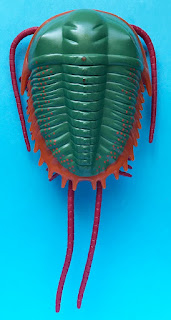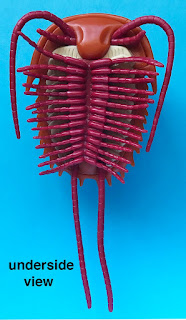Marine shells belonging to the gastropod family Muricidae (muricids) are among some of the most exquisite shells known. Species like those shown below are characterized by having three aligned rows (varices) of prominent spines (can be very sharp) and a prominent siphonal canal. Their shells range in length from 6 mm to 305 mm. Most muricids exude a yellow fluid that, when exposed to sun light, becomes a purple dye. This dye was used by ancient human cultures for making the "royal" Tyrian purple color.
Muricids are voracious predators, and the feed on oysters, other clams, and snails. Muricids bore a hole through the shell of their prey and insert a long proboscis to ingest the prey. Muricids are worldwide in tropical to temperate waters, mostly between 0 to 300 meters depth, although some species occur in deep waters (up to 1900 m depth). They can inhabit rocky or rubble bottoms, but the deeper water forms live on muddy bottoms.

ABOVE: Three views (ventral, side, and dorsal, from top to bottom and left to right) of Siratus alabaster (Reeve, 1845): length 135 mm, width 98 mm. This species is found in deep water off Japan and the Philippines. The shell is white to ivory, and the last whorl (largest one) has three prominent webbed varices, which are the thin, blade-like expansions.
ABOVE: Three views (ventral, side, and dorsal) of Murex cervicornis Lamarck, 1822: length 68 mm, width 57 mm. This species is found eastern Australia. The shell has very stout spines, arranged in three rows.
Four views (ventral, side, dorsal, and living mode) of Murex pecten Lightfoot, 1786: length 140 mm, width 60 mm. This species, which is known also by its common name "Venus Comb," is found throughout tropical waters in the western Pacific (southeast Japan to Queensland, Australia, as well as in the Solomon Islands. The Latin word "pecten" means either "comb" (which applies to its usage for this gastropod), or it can mean "scallop," in reference to a well-known group of bivalve shells.
In the living position, the numerous spines of M. pecten totally protect the animal from predators, when it is at rest or moving about, because it carries its own protective "cage." The spines along the dorsal side are very sharp. The spines nearest the ocean floor are long enough to elevate the shell and prevent it from sinking in muddy sediment. These particular spines are also curved inward.
To see an excellent video showing how Murex pecten ploughs through the sand, go to <www.revolvy.com> Or, you can google: either "Venus comb murex/Revolvy" or "Video matching Venus comb murex/Revolvy." Click on the video indicated in the center of the screen.
The early fossil record of family Muricidae is not well known, but there are a few Late Cretaceous gastropods that might be related.
The first undoubted muricids are of Paleocene age. There a few known Eocene species. By the Miocene, this family became more diverse. Today, there are five known subfamilies and approximately 94 genera.
One of the earliest known muricids on the west coast of North America is shown below. This species is of middle to late middle Eocene age from southern and central California.
Two views (ventral and dorsal) of Laevityphis antiquus (Gabb, 1864) length 9 mm, width 5.5 mm; specimen is from the middle Eocene Ardath Shale, San Diego County, southern California.








































